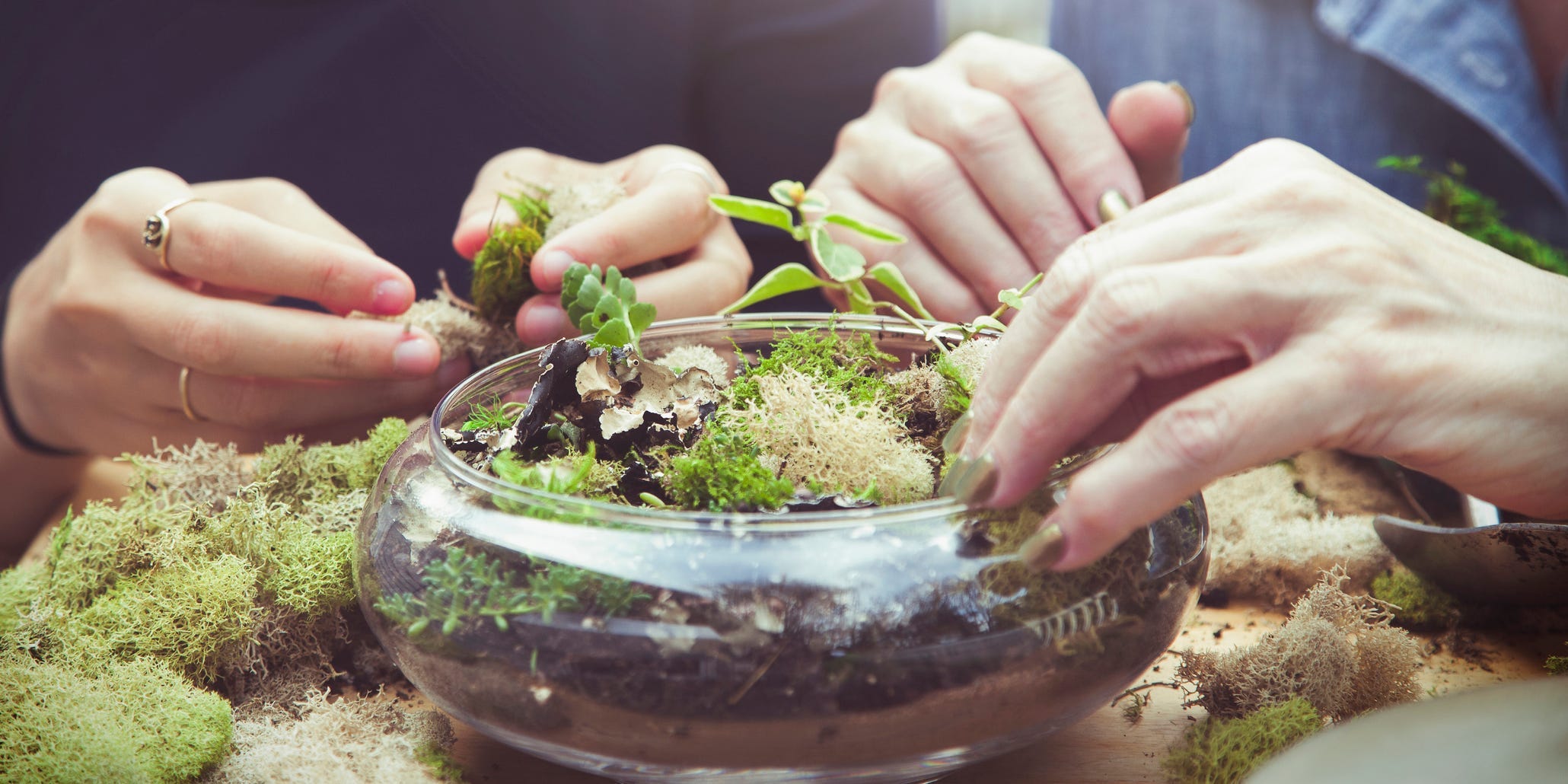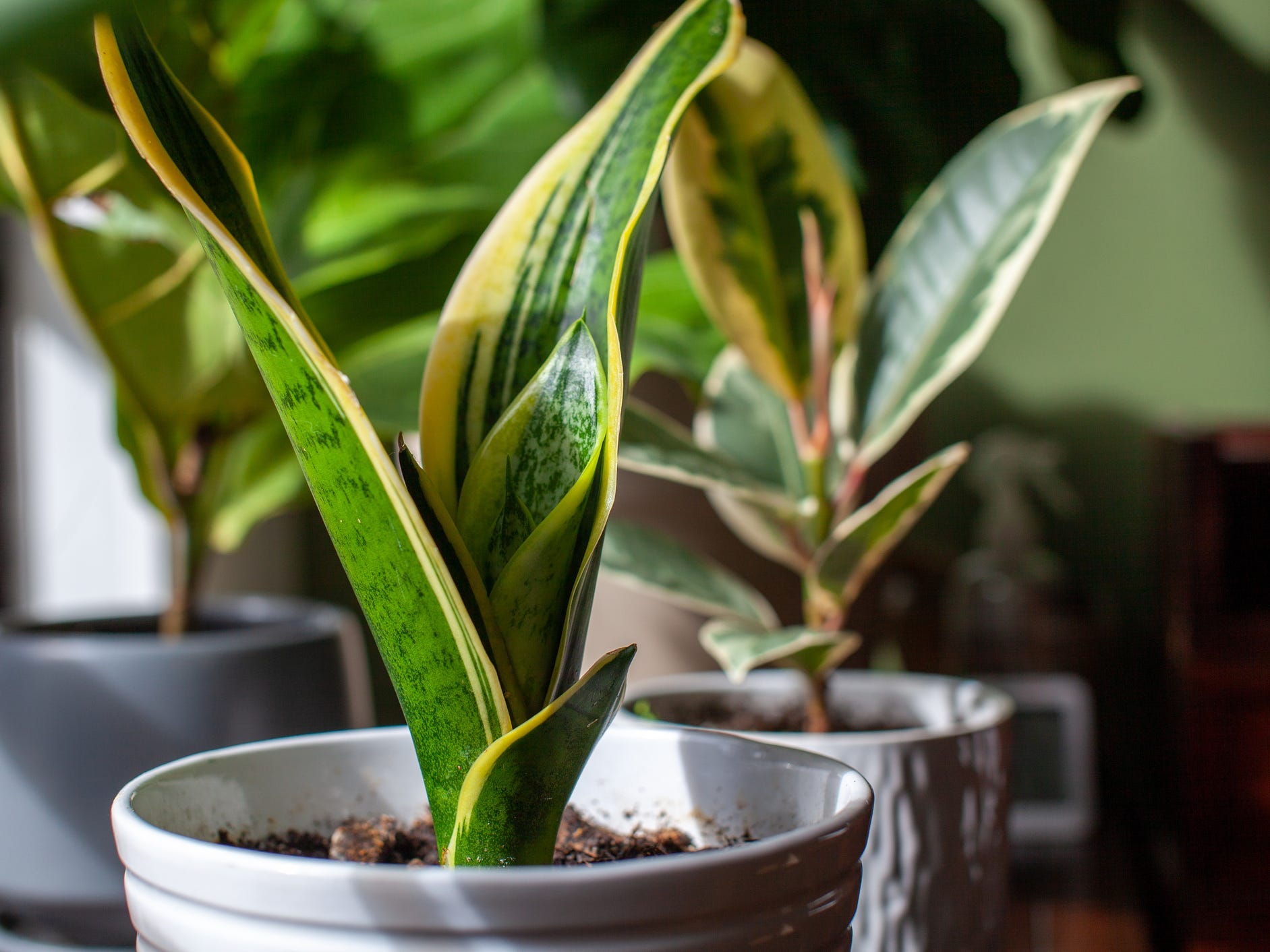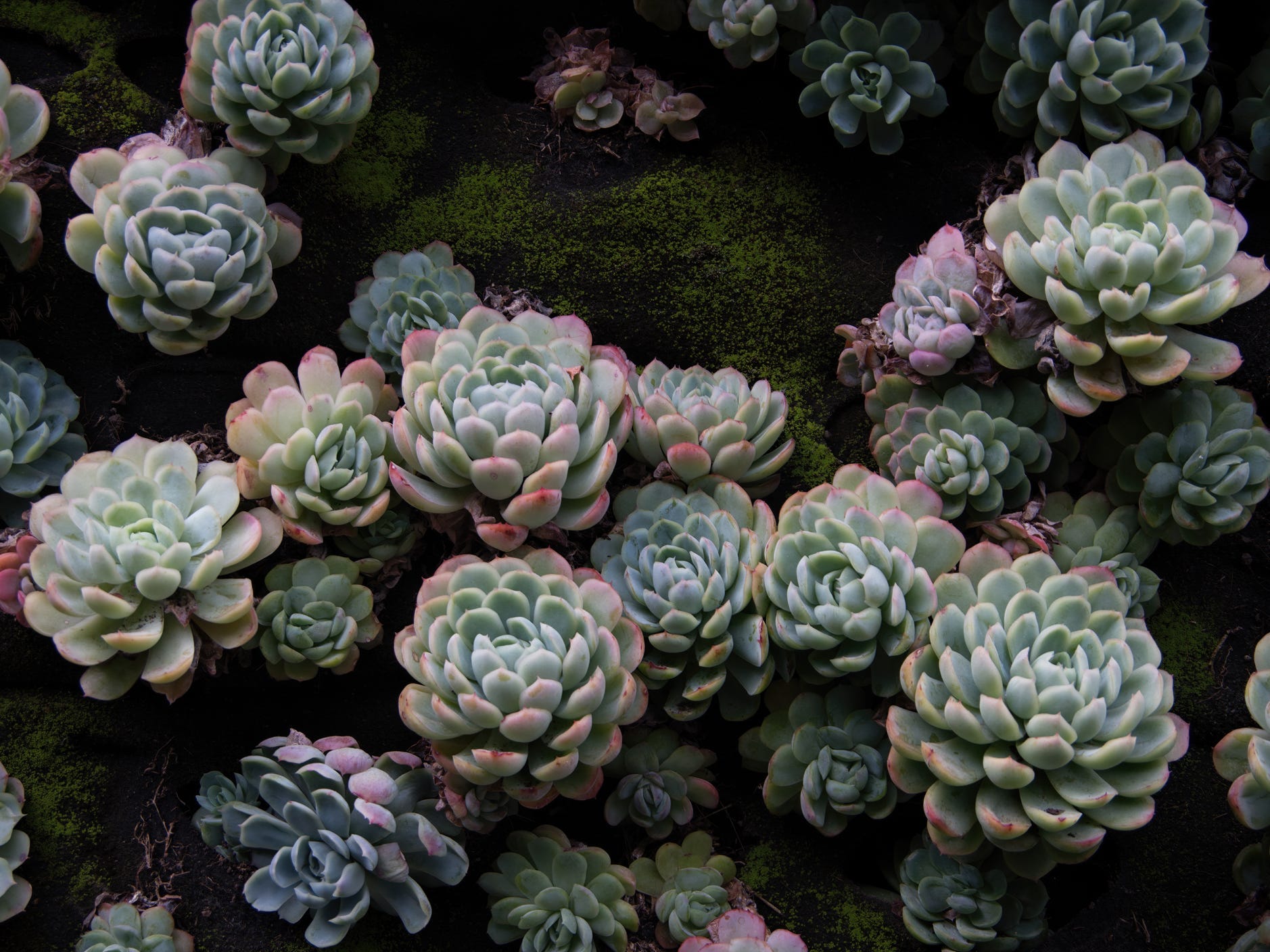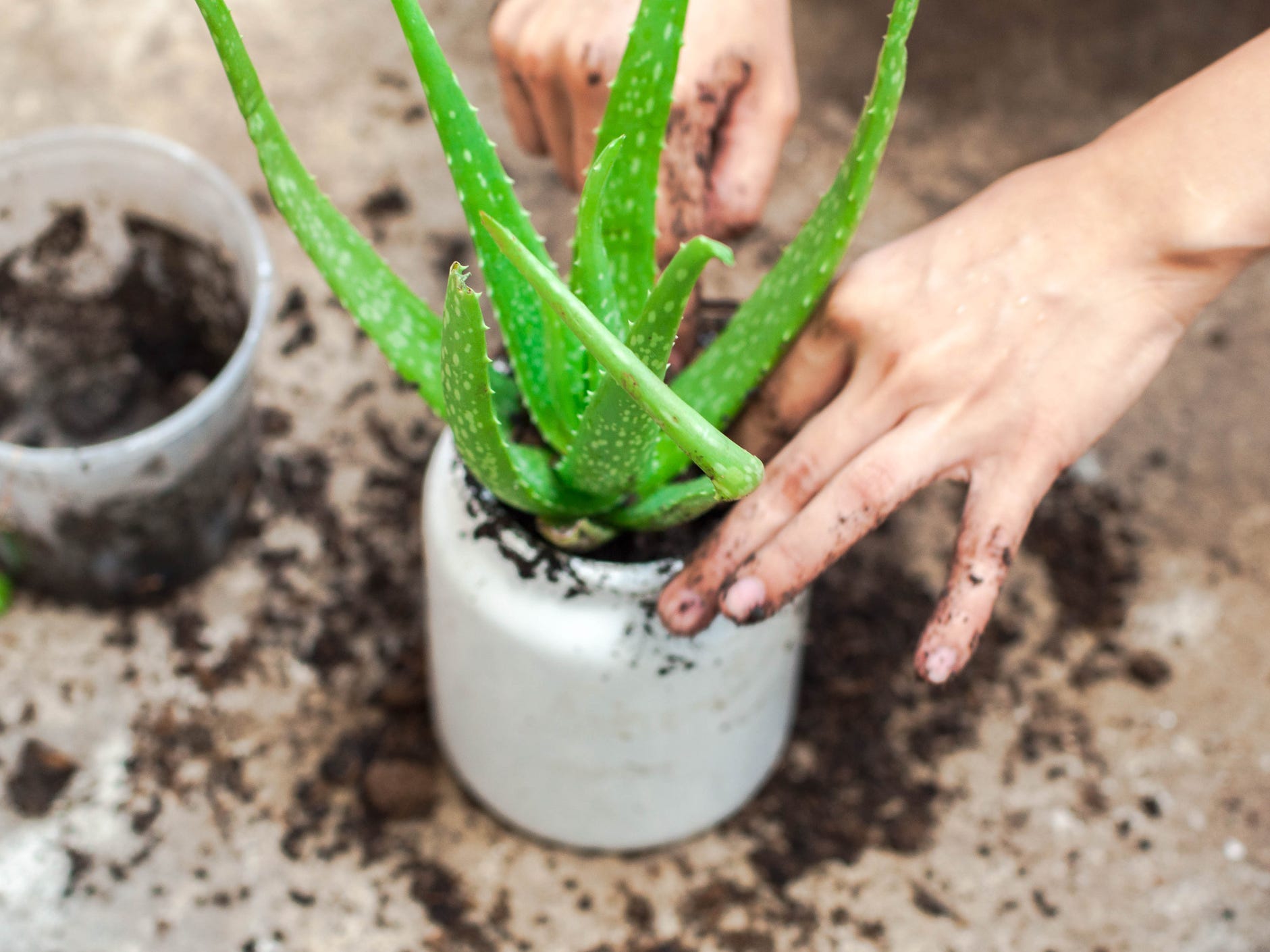
- The best plants for terrariums are small and low maintenance with interesting textures.
- Open and closed terrariums require different plans.
- Use open terrariums for succulents and closed terrariums for humidity-loving tropical plants.
- Visit Insider's Home & Kitchen Reference library for more stories.
As far as decor trends go, terrariums appear to be here to stay — and it's no surprise given that these miniature gardens are fun to design, easy to maintain, and instantly liven up any bookshelf, coffee table, or desk.
A terrarium is a contained ecosystem made up of diverse plants, moss, rocks, and other materials enclosed in a clear vessel, like a glass bowl or jar.
According to Erin Marino, houseplant expert and director of marketing at The Sill, the idea was a happy accident discovered by English doctor Nathaniel Bagshaw Ward. After Ward noticed a fern spore had grown in a closed jar, he had a carpenter build him a prototype for the "Wardian case" — the first terrarium — in 1829, which instantly exploded in popularity.
Today, people use terrariums because they're aesthetically pleasing and they provide conditions that many houseplants require: humidity, moisture, and sunlight.
There are two main types of terrariums, and each provide different conditions for plants to thrive:
- Open terrarium: This type has no lid and can handle more direct sunlight, but may need more frequent watering and pruning. Plants are free to grow larger and extend out of the container. The drainage layers typically consist of pebbles, soil, charcoal, and rocks.
- Closed terrarium: Because this type includes a lid, you'll want to avoid placing them directly in sunlight, as it can burn the plants when the glass heats up. Plants need less maintenance because moisture is constantly recycled. Unlike an open terrarium, the drainage layers don't include pebbles — just soil, charcoal, and rocks.
Here's everything you need to know about what plants work best for open and closed terrariums.
Best plants for open terrariums
"Any plants that prefer an arid, dry environment, like most succulents, will fare better in an open terrarium," says Marino. "That's because an open terrarium has at least one side open, allowing moisture to escape." Here are some great options for open terrariums to get you started.
Snake plant

Not only does it claim a top spot in NASA's Clean Air Study, but the snake plant is also a succulent that can tolerate low light, according to Marino.
That said, this low-maintenance houseplant is happiest in bright to medium indirect light with water every two to three weeks (or whenever leaves start to wrinkle).
Since the snake plant is prone to root rot, it does best in a chunky potting mix that contains additives like perlite and sand to help promote drainage.
Haworthia

With its tentacle-like speckled leaves, this plant is another popular pick for terrariums.
"Hawthorias survive on little more than sunshine — preferably bright direct to indirect — and the occasional watering every couple weeks," says Marino.
Like the snake plant, hawthorias do not like to have their roots wet for long, so it's a good idea to plant them in gravelly or sandy soil with good drainage. Wait for the top of the soil to dry out before watering.
Echeveria

Echeverias are a popular plant for terrariums, not only because they can withstand the dry conditions in most homes but also because they boast fleshy, water-storing leaves that grow in an eye-catching rosette shape, says Marino.
The echeveria requires a porous, well-draining soil — like a succulent mix — and should be watered only when the soil is very dry to avoid root rot. This plant needs at least six hours of bright but indirect sunlight each day.
Burro's tail

With its long, sweeping stems covered in plump overlapping leaves, this plant is a striking addition to any terrarium.
Like other succulents, the burro's tail, or donkey's tail, is tolerant of heat and dry air and only needs to be watered very sparingly. Place your terrarium on a sunny south or west-facing windowsill if you include this plant, as it needs at least a few hours of very bright indirect light daily.
While the burro's tail can be mixed with other plants, make sure to leave plenty of room around it to grow and handle it as delicately as possible since it's highly fragile.
Jade plant

This evergreen plant is a common pick for terrariums because it requires little sunlight and water to survive. Thanks to its smooth, glossy leaves and rich forest-green leaves, its appearance resembles a miniature tree.
Jade plants grow best in a succulent-specific potting mix, and plenty of bright but indirect sunlight so as not to scorch the leaves. This plant only needs to be watered every two to three weeks, except in the warmer, sunnier months, when it may need weekly waterings.
Aloe

Whether placed in a minimalist container all on its own or arranged in a larger vessel with fellow succulents, this hardy plant is a phenomenal choice for terrariums.
With its long, jagged-edged leaves and lush gray-green color, it has a unique cactus-like appearance.
Direct sunlight can burn the tender leaves of an aloe plant, so make sure the terrarium is in a location with ample indirect light. Plant it in fast-draining cacti or succulent soil, and remember the golden rule of "drenches between droughts," watering it thoroughly but infrequently.
Pothos

There's a good reason why the pothos is often referred to as the "cubicle plant," says Marino — it's so indestructible it can grow just about anywhere. As an added bonus, its vines look beautiful trailing out of an open terrarium.
Pothos prefer medium to bright indirect light, according to Marino, but can also tolerate low light. This plant isn't too fussy when it comes to soil, but aim for a nutrient-rich, well-draining mix to make it happiest.Let the soil dry out a little bit, but not completely, between waterings.
Hypoestes polka dot plant

The hypoestes, also known as the polka dot plant, boasts vibrant, speckled leaves that can range from light pink to bright red with a variegated design and green edges.
Rich soil with good drainage, like peat-based soil, works well for this plant. Make sure the hypoestes gets plenty of bright, filtered light, and only water it when the top ½ inch or so of soil has dried out.
Best plants for closed terrariums
Plants that thrive in warm, high-humidity environments — like tropical varieties — work best in enclosed and semi-enclosed terrariums, says Marino.
This is because when you close off the terrarium, such as with a lid on the top of the container, heat from the sun and moisture from the soil gets trapped inside the container, and when it evaporates, it creates condensation on the walls that then falls back onto the soil and plants.
With that in mind, here are some plants that are well-suited to a closed terrarium, according to Marino.
Phalaenopsis orchid

This particular orchid variety, also known as the moth orchid, is often referred to as the "beginner's orchid" because of its easy going nature.
It does best in a bright spot with indirect light, says Marino. The higher the temperature in your home the more humidity this plant will need. Miniature orchids are best suited to terrariums and can be potted in sphagnum moss or a coco plug. Water the orchid weekly during the growing season, and cut back to every other week the rest of the year.
Bird's nest fern

Known for its wavy fronds that grow out of a central rosette, the bird's nest fern enjoys the warm, humid environment of a closed terrarium, according to Marino.
Marino advises avoiding harsh direct sunlight, which can damage the leaves, and placing this plant in a spot with medium-indirect light. Plant it in a peat-based potting mix, which mimics the fern's natural habitat, and only water it when the top inch or two of the soil is dry.
Tillandsia

Tillandsias are commonly known as air plants because they get all of the moisture and nutrients they need from the air — meaning they don't need to be potted in soil.
As such, Marino says they'll be right at home in a closed terrarium, especially when placed in medium to bright filtered light. Make sure to give them an adequate soak by fully submerging the plant in warm or room temperature dechlorinated water at least once a week for 20 to 45 minutes.
Peperomia

Marino says these small, compact plants are a perfect choice for closed terrariums since they mainly grow in tropical and subtropical areas.
They prefer indirect medium sunlight, but can easily tolerate low light as well. A well-draining potting mixture, such as one with 50% peat moss and 50% perlite, works best for this plant. Always wait until the top third of the soil is dry before watering.
Calathea

The foliage on the calathea looks stunning in a terrarium, thanks to the bold patterns and colorful undersides on the leaves. The most unique characteristic of this plant is that its leaves actually move throughout the day as they adjust to changing sunlight.
Direct light is too much for this plant, but it can tolerate anywhere from low to bright indirect light. A well-draining potting mix with bark, perlite, and other nutrient-rich additives works best for the calathea, and make sure to let the soil dry out halfway between waterings.
Fittonia

This tropical plant is native to rainforests, so it'll thrive in a humid closed terrarium. It's often referred to as the "nerve plant" because the distinctive design on the leaves resembles nerve branches, and the foliage may be deep green with bright red or pink veins or vice versa.
They thrive in potting soil with a peat moss base, and in indirect medium light. Water this plant as soon as you notice the top layer of soil has become dry, and mist it in between waterings to revive it.
Creeping fig

This evergreen vine is known for its heart-shaped leaves and fast-growing habits. All it needs is some well-draining soil, bright indirect sunlight, and a humid environment — which conveniently, a closed terrarium can provide.
During the growing season (late spring to late summer), make sure to water your creeping fig consistently to keep the soil slightly moist. During the rest of the year, you can water it only when the top of the soil has dried out.
Baby's tears

There's a reason why this tropical houseplant is often confused for moss: it forms a dense mat of creeping stems and tiny leaves that grow horizontally — making it a nice visual contrast for any closed terrarium.
Place it on an east or west-facing windowsill where it'll only get sun for part of the day, or anywhere that it'll receive bright indirect sunlight. This plant thrives the most in rich, well-draining potting soil with peat moss. Don't let the soil dry out completely, but also avoid drenching it — instead, try to keep it lightly moist at all times.
Tips for building a terrarium
Use this pro guidance from Marino to ensure your terrarium thrives:
- Use a clean, clear container. It's important that the plants in your terrarium get plenty of sunlight.
- Layer gravel or lava rocks under the potting mix. Adding half an inch or so of gravel or lava rocks to the bottom of the terrarium helps excess water to trickle down beneath the soil. It's important to have good drainage to avoid root rot, which happens when the roots sit in water for an extended period of time.
- Press down on the potting mix to remove air pockets. Air pockets inhibit the natural movement of water through the soil, which can result in an under watered plant. Pressing down on the soil before you arrange your plants in the terrarium can help avoid this.
- Leave room between the plants. Make sure that your plants have plenty of space to grow, as overcrowding your terrarium can hinder plant growth and also increase the risk of mold.
- Choose plants with similar needs. No matter which type of terrarium you choose, be sure that all the plants you place in the same vessel share similar potting soil and sunlight requirements to encourage growth.
Insider's takeaway
Terrariums aren't just an attractive form of decor, they're also a great way to grow indoor plants that otherwise wouldn't adapt to the typical home atmosphere.
While plants that prefer dryer environments — like succulents, cacti, and others native to the desert — will do best in an open terrarium, a closed terrarium provides an environment with higher humidity that some tropical plants require to thrive.
Dit artikel is oorspronkelijk verschenen op z24.nl
